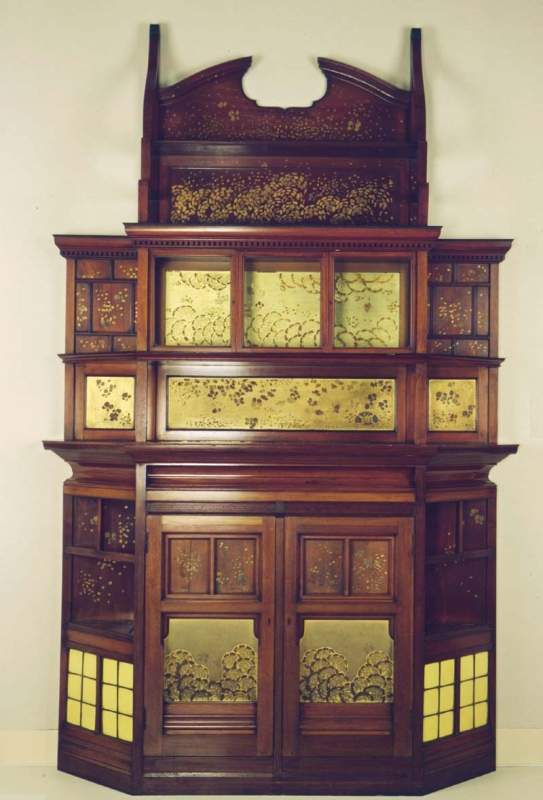Home > Catalogue > Browse > Harmony in Yellow and Gold: The Butterfly Cabinet << >>
Composition
The patterns painted on the fireplace panels (and now on Harmony in Yellow and Gold: The Butterfly Cabinet) have been variously described as cloud, wave, fish scale patterns etc. They are somewhat similar to motifs seen on the walls, ceiling and panels of Harmony in Blue and Gold: The Peacock Room [YMSM 178], painted between 1876 and 1877, which were described by Whistler as 'A pattern, invented from the Eye of the Peacock' and 'a pattern devised from the breast-feathers.' Indeed, when Godwin visited the Peacock Room, he sketched these feather patterns on his copy of Whistler's pamphlet. 1
David Park Curry suggests sources for the Peacock Room designs, including fish scale patterns reproduced by G. A. Audsley and J. L. Bowes in The Keramic Art of Japan in 1881, and ancient wave patterns in Owen Jones's The Grammar of Ornament, published in 1856. 2
Bendix suggested that Whistler's painted designs for the cabinet 'were based on Japanese screen painting, the petal design is similar to that on his golden staircase at No. 2 Lindsey Row, and the cloud (or wave) pattern is essentially the same as that in the Peacock Room.' 3 However, the staircase decoration, Panels from the Entrance Hall at 49 Princes Gate [YMSM 175], has little in common with the fireplace and stand decorations, apart from being in gold.
The Pennells (1908) thought that Whistler's decorations might have originated in a design intended for William Cleverly Alexander (1840-1916), the London banker; their take on this emphasizes Whistler's input on the exhibition stand:
'In the Paris International Exhibition of 1878, Whistler showed the section of a room decorated by him, his only exhibit. ... It may have been the design he wanted to carry out for Mr. Alexander; most likely, it was intended for the decoration of the White House, which E. W. Godwin, the architect, was building for him in Tite Street, Chelsea.' 4
This is unconvincing, since the surviving pen drawings by Whistler for panelling and shelving intended for Alexander's Aubrey House are actually very simple and unadorned, whatever his ideas may have been for developing these. 5
Hilary Taylor considered the design and furniture for the Watt & Co. stand were a 'trial run' for Whistler's White House. 6 Likewise, Linda Merrill suggested that it was intended for the 'Primrose Room' in the White House. 7
Technique
Whistler's original work was apparently damaged in March 1878 shortly before the fireplace/cabinet and surrounds were sent to Paris. He complained to Godwin:
'You know the work I have done for your client - and you know the thorough way in which I have carried it out - far beyond the original proposal from you - You know also the vexations I have been subjected to in the way of painting completed and destroyed afterwards by the blundering of Mr Watt's men - The work having consequently to be done over again at great loss of most precious time to me, … appointments made and not kept by his people, involving the giving up of an entire day (Saturday) that I might carry through the Cabinet &c ... in time for Mr Watts exhibition here prior to his sending off.' 8
It is not clear how extensive the damage was, and whether it was to the cabinet (note that at this point Whistler does describe his work as being on the 'Cabinet'), the side-panels or overmantel, or to the dado or the stand itself.
The side panels, and the central section above the fireplace, were decorated by Whistler with Japanese 'cloud' motifs and butterflies on a primrose yellow ground, and the mahogany panels were decorated with similar motifs, or butterflies and petals in gold. It was signed with Whistler's butterfly monogram at the lower right corner of the wide central panel immediately above the mantelpiece.
As exhibited on Watt's stand, the wall to left and right of the fireplace/cabinet, above the dado, was painted with more cloud patterns, and was signed with a butterfly above these patterns, to right of the fireplace.
Conservation History
The fireplace was converted into a cabinet by replacing the grate with doors adapted from the dado. This may have been carried out by the firm of Watt & Co., or possibly when it was acquired by Pickford Waller. 9 The three panels that made up the dado to left of the fireplace were moved and became the cupboard door at left, and those to right became the door at right.
Notes:
1: Whistler 1877 C [more], annotated copy in GUL Sp Coll Whistler 246; Aslin, Elizabeth, E. W. Godwin, Furniture and Interior Decoration, London, 1986, pp. 13-14 (cat. no. 9), plate 64.
2: Curry also notes that the 'reflective qualities' of the gilding and glazing 'lighten the cabinet's otherwise ponderous form.' Curry 1984 [more], p. 66. Audsley, George Ashdown, and James L. Bowes, The Keramic Art of Japan, London, 1881; Jones, Owen, The Grammar of Ornament, London, 1856.
3: Bendix 1995 [more], p. 165.
4: Pennell 1908 [more], vol. 1, p. 219.
5: e.g. Designs for the arrangement of china in the dining room at Aubrey House [M.0487], and Designs for the dining-room at Aubrey House: (a) chairs and door, plates on wall; (b) vase in arched recess [M.0488].
7: Merrill 1998 [more], p. 261.
Last updated: 22nd May 2021 by Margaret










